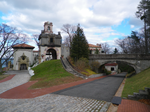WHFM
1971 establishments in New York (state)Classic rock radio stations in the United StatesCox Media GroupHD Radio stationsMass media in Suffolk County, New York ... and 2 more
Radio stations established in 1971Radio stations in New York (state)
WHFM (95.3 FM) is a classic rock radio station licensed to Southampton, New York, and serving eastern Long Island. It is owned by Cox Radio and simulcasts 102.3 WBAB.
Excerpt from the Wikipedia article WHFM (License: CC BY-SA 3.0, Authors).WHFM
Bayberry Road,
Geographical coordinates (GPS) Address Nearby Places Show on map
Geographical coordinates (GPS)
| Latitude | Longitude |
|---|---|
| N 40.934805555556 ° | E -73.387027777778 ° |
Address
Bayberry Road 53
11768
New York, United States
Open on Google Maps








